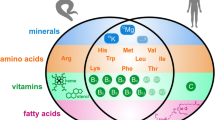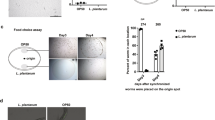Abstract
Effects exerted by heavy isotope substitution in biopolymers on the functioning of whole organisms have not been investigated. We report on the decrease of permissive temperature of nematodes fed with bacteria containing 5,5-d2-lysine. We synthesized 5,5-dideuterolysine and, taking advantage of lysine being an essential amino acid, showed that C. elegans with modified lysine poorly develop from larvae into fertile adult hermaphrodites. This effect occurs only at high temperature within the permissible range for C. elegans (25 °C) and completely vanishes at 15 °C. The only known metabolic involvement of C5 in lysine is in post-translational modification through lysyl hydoxylases. Indeed, siRNA experiments showed that deficiency of let-268/plod lysyl-hydroxylase/glycosydase further amplifies the isotope effect making it apparent even at 20 °C, whereas control siRNAs as well as another lysyl-hydroxylase (psr-1/jmjdD) siRNA do not. We report for the first time that a site-specific deuteration may strongly affect the development of the whole animal organism especially under the conditions of deficiency of the corresponding enzyme. These findings provide the basis for our ongoing efforts to employ isotope effects for fine tuning of metabolic pathways to mitigate pathological processes.





Similar content being viewed by others
Abbreviations
- IRMS:
-
Isotope ratio mass spectrometry
- KIE:
-
Kinetic isotope effect
- LOX:
-
Lysyl oxidase
- PBS:
-
Phosphate buffered saline
- PLOD:
-
Procollagen-lysine 5-dioxygenase
References
Baba T, Ara T, Hasegawa M, Takai Y, Okumura Y, Baba M, Datsenko KA, Tomita M, Wanner BL, Mori H (2006) Construction of Escherichia coli K-12 in-frame, single-gene knockout mutants: the Keio collection. Mol Syst Biol 2:1–11
Bunt S, Denholm B, Skaer H (2011) Characterisation of the Drosophila procollagen lysyl hydroxylase, dPlod. Gene Expr Pattern 11:72–78
Dowse HB, Palmer JD (1972) The chronomutagenic effect of deuterium oxide on the period and entrainment of a biological rhythm. Biol Bull 143:513–524
Fredens J, Engholm-Keller K, Giessing A, Pultz D, Larsen MR, Højrup P, Møller-Jensen J, Færgeman NJ (2011) Quantitative proteomics by amino acid labeling in C. elegans. Nat Methods 28:845–847
Gaweska H, Henderson Pozzi M, Schmidt DM, McCafferty DG, Fitzpatrick PF (2009) Use of pH and kinetic isotope effects to establish chemistry as rate-limiting in oxidation of a peptide substrate by LSD1. Biochemistry 48:5440–5545
Glickman MH, Wiseman JS, Klinman JP (1994) Extremely large isotope effects in the soybean lipoxygenase-linoleic acid reaction. J Am Chem Soc 116:793–794
Hahn P, Böse J, Edler S, Lengeling A (2008) Genomic structure and expression of Jmjd6 and evolutionary analysis in the context of related JmjC domain containing proteins. BMC Genomics 9(1):293
Hill S, Hirano K, Shmanai VV, Marbois BN, Vidovic D, Bekish AV, Kay B, Tse V, Fine J, Clarke CF, Shchepinov MS (2011) Isotope-reinforced polyunsaturated fatty acids protect yeast cells from oxidative stress. Free Radic Biol Med 50(1):130–138
Hughes AM, Calvin M (1958) Production of sterility in mice by deuterium oxide. Science 127:1445–1446
Hughes AM, Bennett EL, Calvin M (1959) Production of sterility in mice by deuterium oxide. Proc Natl Acad Sci USA 45:581–586
Katz JJ, Crespi HL, Czajka DM, Finkel AJ (1962) Course of deuteriation and some physiological effects of deuterium in mice. Am J Physiol 203:907–913
Kushner DJ, Baker A, Dunstall TG (1999) Pharmacological uses and perspectives of heavy water and deuterated compounds. Can J Physiol Pharmacol 77:79–88
Lamberson CR, Xu L, Muchalski H, Montenegro-Burke JR, Shmanai VV, Bekish AV, McLean JA, Clarke CF, Shchepinov MS, Porter NA (2014) Unusual Kinetic Isotope Effects of Deuterium Reinforced Polyunsaturated Fatty Acids in Tocopherol-Mediated Free Radical Chain Oxidations. J Am Chem Soc 136(3):838–841
Larance M, Bailly AP, Pourkarimi E, Hay RT, Buchanan G, Coulthurst S, Xirodimas DP, Gartner A, Lamond AI (2011) Stable-isotope labeling with amino acids in nematodes. Nat Methods 28:849–851
Lowenson JD, Shmanai VV, Shklyaruck D, Clarke SG, Shchepinov MS (2016) Deuteration protects asparagine residues against racemization. Amino Acids 48:2189–2196
Mantri M, Loik ND, Hamed RB, Claridge TD, McCullagh JS, Schofield CJ (2011) The 2-oxoglutarate-dependent oxygenase JMJD6 catalyses oxidation of lysine residues to give 5S-hydroxylysine residues. ChemBioChem 12:531–534
Matsuba C, Ostrow DG, Salomon MP, Tolani A, Baer CF (2013) Temperature, stress and spontaneous mutation in Caenorhabditis briggsae and Caenorhabditis elegans. Biol Lett 9:20120334
Neidhardt FC, Bloch PL, Smith DF (1974) Culture medium for enterobacteria. J Bacteriol 119:736–744
Norman KR, Moerman DG (2000) The let-268 locus of Caenorhabditis elegans encodes a procollagen lysyl hydroxylase that is essential for type IV collagen secretion. Dev Biol 227:690–705
Patananan AN, Budenholzer LM, Pedraza ME, Torres ER, Adler LN, Clarke SG (2015) The invertebrate Caenorhabditis elegans biosynthesizes ascorbate. Arch Biochem Biophys 569:32–44
Peng S, van der Donk WA (2003) An unusual isotope effect on substrate inhibition in the oxidation of arachidonic acid by lipoxygenase. J Am Chem Soc 125:8988–8989
Pestov NB, Okkelman IA, Shmanai VV, Hurski AL, Giaccia AJ, Shchepinov MS (2011) Control of lysyl oxidase activity through site-specific deuteration of lysine. Bioorg Med Chem Lett 21:255–258
Pittendrigh CS, Caldarola PC, Cosbey ES (1973) A differential effect of heavy water on temperature-dependent and temperature-compensated aspects of circadian system of Drosophila pseudoobscura. Proc Natl Acad Sci USA 70:2037–20341
Rautavuoma K, Takaluoma K, Sormunen R, Myllyharju J, Kivirikko KI, Soininen R (2004) Premature aggregation of type IV collagen and early lethality in lysyl hydroxylase 3 null mice. Proc Natl Acad Sci USA 101:14120–14125
Richter CP (1977) Heavy water as a tool for study of the forces that control length of period of the 24-hour clock of the hamster. Proc Natl Acad Sci USA 74:1295–1299
Schneider VA, Granato M (2007) Genomic structure and embryonic expression of zebrafish lysyl hydroxylase 1 and lysyl hydroxylase 2. Matrix Biol 26:12–19
Shchepinov MS (2007a) Do “heavy” eaters live longer? BioEssays 29:1247–1256
Shchepinov MS (2007b) Reactive oxygen species, isotope effect, essential nutrients, and enhanced longevity. Rejuvenation Res 10:47–59
Shchepinov MS, Pestov NB (2010) Isotope effect, essential diet components, and prospects of aging retardation. Russ J Gen Chem 80:1514–1522
Sipilä L, Ruotsalainen H, Sormunen R, Baker NL, Lamandé SR, Vapola M, Wang C, Sado Y, Aszodi A, Myllylä R (2007) Secretion and assembly of type IV and VI collagens depend on glycosylation of hydroxylysines. J Biol Chem 282:33381–33388
Umagat H, Kucera P, Wen L-F (1982) Total amino acid analysis using pre-column fluorescence derivatization. J Chromatogr 239:463–474
Uphaus RA, Crane FA, Blake MI, Katz JJ (1965) Effects of heavy water on Atropa belladonna. J Pharm Sci 54:202–205
Vasdev S, Sampson CA, Longerich L, Parai S (1991) Deuterium oxide prevents hypertension and elevated cytosolic calcium in hypertensive rats. Hypertension 18:550–557
Wang X, Wu YC, Fadok VA, Lee MC, Gengyo-Ando K, Cheng LC, Ledwich D, Hsu PK, Chen JY, Chou BK, Henson P, Mitani S, Xue D (2003) Cell corpse engulfment mediated by C. elegans phosphatidylserine receptor through CED-5 and CED-12. Science 302:1563–1566
White L, Ringo J, Dowse H (1992a) A circadian clock of Drosophila: effects of deuterium oxide and mutations at the period locus. Chronobiol Int 9:250–259
White LA, Ringo JM, Dowse HB (1992b) Effects of deuterium oxide and temperature on heart rate in Drosophila melanogaster. J Comp Physiol B 162:278–283
Acknowledgements
We are grateful to S. Clarke and C. Kenyon for helpful advice. This work was supported by the Russian Foundation for Basic Research (Grant 16-04-00828), and MCB program of Russian Academy of Sciences.
Author information
Authors and Affiliations
Corresponding authors
Ethics declarations
Conflict of interest
M. S. Shchepinov declares a competing financial interest as the Chief Scientific Officer of Retrotope, Inc.
Funding
This work was supported by the Russian Foundation for Basic Research (Grant 16-04-00828 to TVK) and MCB program of Russian Academy of Sciences (NBP).
Research involving human participants and/or animals
This article does not contain any studies with human participants performed by any of the authors. All applicable international, national, and/or institutional guidelines for the care and use of animals were followed.
Informed consent
Not applicable.
Electronic supplementary material
Below is the link to the electronic supplementary material.
Rights and permissions
About this article
Cite this article
Korneenko, T.V., Pestov, N.B., Hurski, A.L. et al. A strong developmental isotope effect in Caenorhabditis elegans induced by 5,5-deuterated lysine. Amino Acids 49, 887–894 (2017). https://doi.org/10.1007/s00726-017-2386-5
Received:
Accepted:
Published:
Issue Date:
DOI: https://doi.org/10.1007/s00726-017-2386-5




